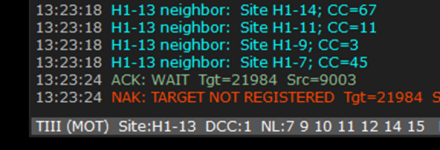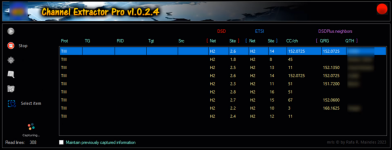I don't know if all of us who use this magnificent decoding tool have realized some errors that have been made when analyzing networks and sites.
The first of them is related to the naming of area.site, I think they have tried to correct this failure, the ETSI tells us that depending on the type of network a total of 10 bits will be used for the Huge model, 8 bits for the Large model , 5 bits for the Small model and 3 bits for the Tiny model for the site naming. On the contrary, the DSD+ and DSD+ Fastlane use a certain number of bits for the area, leaving the last three for the site in the first three models and 2 bits for the Tiny model.
What was expressed in the previous paragraph seems that they have tried to solve it since in my events window the sites named as indicated in the ETSI appear, however, they have made other types of errors that I did not see previously.
To explain it I will use these three examples:
If I take the first example as a basis, I note that the SysCode is 11.00.0001111100, this means that I am looking at a Huge type network model:

11.00.0001111100
Network Huge Type: 11 -> H
Network ID: 00 -> 0 + 1 = 1
Site: 0001111100 -> 174 or according to DSD+ 15 + 1 (16) for the area and 4 + 1 (5) for the site
In this case I think it is correct to add 1 to both the id and the area and the site, so what is indicated by the ETSI should also be added 1, since no one starts counting at zero, even if it is used in programming to indicate the first value or the first character or the first record…
In the second example we already found these contradictions or errors, we will look at a SysCode with the same network model, specifically 11.01.0000001101, in the image you can see that they use the ETSI nomenclature:

11.01.0000001101
Network Huge Type: 11 -> H
Network ID: 01 -> 1, if the usage rule of the previous example is applied it would be 1 + 1 = 2
Site: 0000001101 -> 13, if the usage rule from the previous example is applied it would be 13 + 1 = 14
In the third example, a network has been presented again according to the DSD+ nomenclature, it is a Large network model with a SysCode equal to 10.0000.00011111:

10.0000.00011111
Large network type: 10 -> L
Network ID: 0000 -> 0 + 1 = 1
Site: 00011111 -> 31 or according to DSD+ 3 + 1 (4) for the area and 7 + 1 (8) for the site
My intention is not to criticize this tool or those who have created it, but to clarify or ask that a single model be developed for the naming of networks and sites, as I have always said, I don't care if they call me by my nickname or by my name as long as when they do it they know that it is me who they are calling, but in the case at hand, it would be good if we all spoke a single language, that we named these networks and sites in a single way so that we can understand each other among all, thank you all.
The first of them is related to the naming of area.site, I think they have tried to correct this failure, the ETSI tells us that depending on the type of network a total of 10 bits will be used for the Huge model, 8 bits for the Large model , 5 bits for the Small model and 3 bits for the Tiny model for the site naming. On the contrary, the DSD+ and DSD+ Fastlane use a certain number of bits for the area, leaving the last three for the site in the first three models and 2 bits for the Tiny model.
What was expressed in the previous paragraph seems that they have tried to solve it since in my events window the sites named as indicated in the ETSI appear, however, they have made other types of errors that I did not see previously.
To explain it I will use these three examples:
If I take the first example as a basis, I note that the SysCode is 11.00.0001111100, this means that I am looking at a Huge type network model:

11.00.0001111100
Network Huge Type: 11 -> H
Network ID: 00 -> 0 + 1 = 1
Site: 0001111100 -> 174 or according to DSD+ 15 + 1 (16) for the area and 4 + 1 (5) for the site
In this case I think it is correct to add 1 to both the id and the area and the site, so what is indicated by the ETSI should also be added 1, since no one starts counting at zero, even if it is used in programming to indicate the first value or the first character or the first record…
In the second example we already found these contradictions or errors, we will look at a SysCode with the same network model, specifically 11.01.0000001101, in the image you can see that they use the ETSI nomenclature:

11.01.0000001101
Network Huge Type: 11 -> H
Network ID: 01 -> 1, if the usage rule of the previous example is applied it would be 1 + 1 = 2
Site: 0000001101 -> 13, if the usage rule from the previous example is applied it would be 13 + 1 = 14
In the third example, a network has been presented again according to the DSD+ nomenclature, it is a Large network model with a SysCode equal to 10.0000.00011111:

10.0000.00011111
Large network type: 10 -> L
Network ID: 0000 -> 0 + 1 = 1
Site: 00011111 -> 31 or according to DSD+ 3 + 1 (4) for the area and 7 + 1 (8) for the site
My intention is not to criticize this tool or those who have created it, but to clarify or ask that a single model be developed for the naming of networks and sites, as I have always said, I don't care if they call me by my nickname or by my name as long as when they do it they know that it is me who they are calling, but in the case at hand, it would be good if we all spoke a single language, that we named these networks and sites in a single way so that we can understand each other among all, thank you all.


